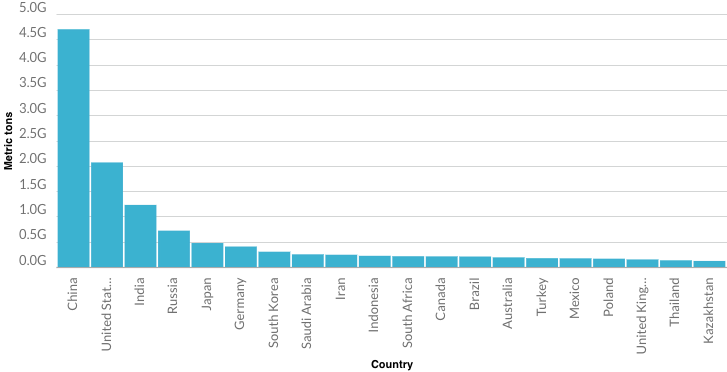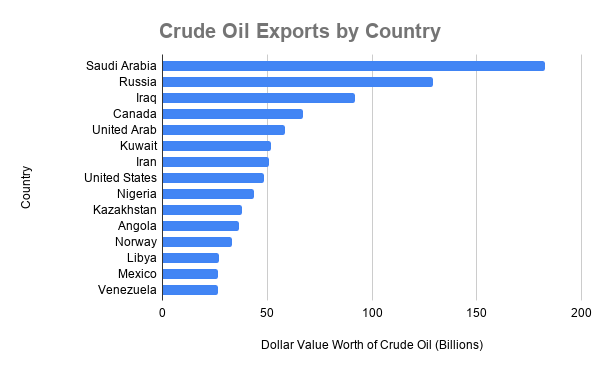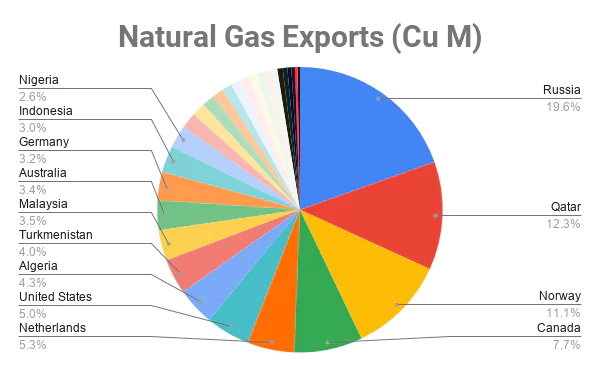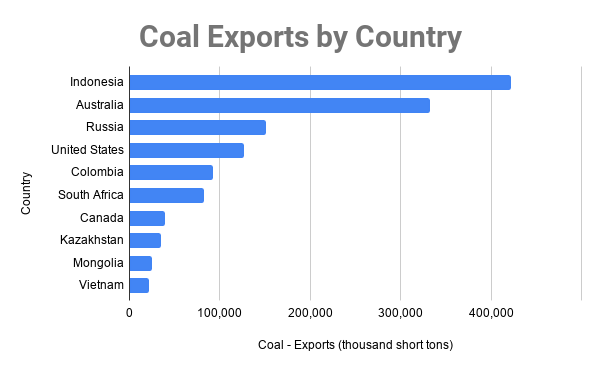The Current State of the Fossil Fuel Industry
The fossil fuel industry is the world’s largest energy industry. As of 2020, fossil fuels are the world’s dominant energy source, accounting for around 82% of the global energy supply. Which countries produce the most fossil fuels in the world? The United States is the largest producer of fossil fuel in the world, producing about 20% of all global fossil fuels, followed by Russia and Iran. Canada is 4th on the list producing about 5% of the world’s fossil fuels. The fossil fuel industry (coal, oil, and gas) have, and continue to, play a dominant role in global energy systems. Fossil energy was a fundamental driver of the Industrial Revolution and the technological, social, economic and development progress which has followed. Energy has played a strongly positive role in global change.
Through a global network of international buyers, suppliers and support all over the world, BizVibe helps facilitate trade for fossil fuels products; advocates for the use of ethical sourcing of oil, natural gas, and coal; and promotes the benefits of fossil fuels trade through education and connect industry leaders through a robust membership program and encourages seamless international trade between global partners all through one platform. This fact sheet is for you if you are looking to trade with leading fossil fuel industry companies in 2020 and are trying to figure out all the details and barriers to best assist you through this process.
BizVibe is already helping dozens of buyers and sellers of fossil fuels connect. See how BizVibe can help you too.
What are Fossil Fuels?
Around 360 to 286 million years ago, plants and organisms died and sank — eventually forming the fossil fuels that we use today as an energy source. You often hear about different types of fossil fuels but what are the 4 types of fossil fuels? The four types of fossil fuels are petroleum, coal, natural gas, and Orimulsion (Orimulsion is a registered trademark name for a bitumen-based fuel that was developed for industrial use).
Fossil fuels are formed by natural processes, such as through the decomposition process of buried dead organisms, containing energy originating in ancient photosynthesis. These organisms and their resulting fossil fuels typically have an age of millions of years, and sometimes more than 650 million years.
Aside from Orimulsion (which is a proprietary energy spruce), there are three main types of fossil fuels we used today: coal, petroleum and natural gas. Coal is cheap, abundant and widely used. Petroleum —also known as crude oil — is typically a bit cleaner-burning energy source, and unlike coal, it can be easily pumped through pipelines and refined into fuels like kerosene and gasoline. Natural gas is also relatively inexpensive and less polluting than coal or crude oil. Natural gas is also a popular choice of fuel, as it’s less expensive and less polluting compare to coal and crude oil.
Where are these fossil fuels found? Fossil fuels are found underground, trapped in deposits surrounded by layers of rock. Coal beds are found lying about 200 to 300 feet below the surface. Oil and natural gas deposits are typically a mile or two down, and the deepest oil and gas wells have reached more than six miles below the surface.
Electricity Generation from Fossil Fuels
In the fossil fuel industry, plants use either coal (60%), oil (10%) or gas (30%) in purpose-designed combustion chambers to raise steam. 30 years ago, oil accounted for 30% of the consumption of fossil fuels, but it has been replaced by coal as oil prices increased faster than the price of coal due supply.
Coal, however, is the least convenient fossil fuel type, as its calorific content, on average, is less than half that of the other two fuels. Handling and transporting it is also more difficult and it produces large quantities of residues, ash and greenhouse gases, some of which are toxic, depending on the quality of the coal.
How Efficient are Fossil Fuels?
There are three different conversion processes, thermal, mechanical and electrical, used to extract the energy from fossil fuels. Taking that into consideration, and as an example, the overall efficiency of a modern fossil fuel-based electrical power generating plant will be about 40%.
- The average efficiencies of power generation for coal: 35%
- The average efficiencies of power generation for natural gas: 45%
- The average efficiencies of oil-fired power generation: 38%
Natural gas is the most efficient fossil fuel type, followed by oil. Coal remains the least efficient fossil fuel type.
Fossil Fuel Consumption by Country
which countries in the world use the most fossil fuels? Nearly 15 billion metric tons of fossil fuels are consumed every year. Three countries use more fossil fuels than the rest of the world combined: China, the United States, and India. The USA, China, and India combined consume 54% of the world’s fossil fuels by weight.

Source: Global Material Flow Database
Highest Consumption of Fossil Fuels Per Capita?
The countries that consume the most fossil fuels aren’t surprising as they consist of 43% of the world’s total population. China, for example, has a population of 1.38 billion people and consumes about 4.7 billion metric tons of fossil fuels each year — which is 31% of the global consumption of total fossil fuels. Per person, that is 3.4 metric tons; The USA consumers twice that amount per person.
Per capita, there are seven countries leading the way for fossil fuel consumption: Equatorial Guinea, Estonia, Singapore, Qatar, Trinidad and Tobago, United Arab Emirates, and Kuwait consume about 10 or more tons of fossil fuels per person. Equatorial Guinea leads the world in per capita fossil fuel consumption, at 18 metric tons per person per year.
How Much Energy From Fossil Fuels
The United States gets 81% of its total energy from oil, coal, and natural gas, all of which are fossil fuels. The US depends on those fuels to heat our homes, run our vehicles, power industry, and manufacturing, and provide us with electricity.
- Fossil fuels currently supply roughly 80 to 85 percent of the world’s energy,
Fossil Fuel Production by Country
Which countries produce the most fossil fuels? The United States produces 20% of all global fossil fuels, with Russia and Iran rounding out the top three. After that comes Canada, which produces just under 5% of all fossil fuels globally.
Ranking Total Fossil Fuel Production by Country
| Ranking | Country |
| 1 | United States of America |
| 2 | Russia |
| 3 | Iran |
| 4 | Canada |
| 5 | Qatar |
| 6 | China |
| 7 | Norway |
| 8 | Australia |
| 9 | Saudi Arabia |
| 10 | Algeria |
Source: https://www.911metallurgist.com/fossil-fuel-production-by-country-mapped/
Fossil Fuel Production by Category
Total Oil Production by Country
Oil formed when small organisms like zooplankton and algae died and fell to the bottom of the sea. Over time, they got trapped under multiple layers of sand and mud. Intense amounts of pressure caused this complex organic matter to decompose and it eventually formed into oil. It is extracted and sold mainly as fuel. Although Venezuela has the largest proven oil reserves in the world, it is only 12th in terms of oil production. The USA is the world’s biggest producer, producing 18% of the world‘s oil, followed by Saudi Arabia and Russia. Next on the list? Canada, which produces just under 6% of the world‘s oil.
Ranking Total Oil Production by Country
| Ranking | Country |
| 1 | United States of America |
| 2 | Saudi Arabia |
| 3 | Russia |
| 4 | Canada |
| 5 | China |
| 6 | Iraq |
| 7 | Iran |
| 8 | United Arab Emirates |
| 9 | Brazil |
| 10 | Kuwait |
Total Natural Gas production by Country
Natural Gas underwent the same process as oil, but for a much longer period and with greater heat and pressure, which caused even more decomposition. Today, natural gas is mainly used for electricity generation, heating, and cooking. It is also used to make chemical products such as fertilizers and dyes. USA are once again top of the production list, producing nearly 20% of all natural gas. Followed in second place by Russia and then in third, Iran. Canada again comes in fourth place, producing almost 5% of the world‘s natural gas.
Ranking Total Natural Gas Production by Country
| 1 | United States of America |
| 2 | Russia |
| 3 | Iran |
| 4 | Canada |
| 5 | Qatar |
| 6 | China |
| 7 | Norway |
| 8 | Australia |
| 9 | Saudi Arabia |
| 10 | Algeria |
Total Coal production by Country
The first reported use of coal dates as far back as 4000BC in China. Coal is formed from ferns, plants and trees which over time have hardened due to the immense pressure and heat found underground. Coal is mostly used to generate electricity, create steel & cement and is also sometimes used as a liquid fuel. Today, China is the world’s biggest producer, producing over 45% of the world‘s coal, followed by India and then the USA. This time Canada is only the 13th biggest producer of coal, producing just under 1%.
Ranking Total Coal Production by Country
| Ranking | Country |
| 1 | China |
| 2 | India |
| 3 | United States of America |
| 4 | Australia |
| 5 | Indonesia |
| 6 | Russia |
| 7 | South Africa |
| 8 | Germany |
| 9 | Poland |
| 10 | Kazakhstan |
Largest Trading Partners – Fossil Fuel Imports and Exports
- Petroleum, natural gas, and coal are exported from various source countries to countries reliant on these fossil fuels.
Crude Oil Exports by Country

Source: World’s Top Exports
- Saudi Arabia is the largest exporter of crude petroleum in the world.
- Crude oil amounts to 5.9% of the worldwide value of all export products
- Since 2014: United States (up 292.1%), Libya (up 69.4%), Iran (up 30.5%) and Iraq (up 9%)
- The People’s Republic of China incurred the highest amount of red ink trading crude oil on international markets
Natural Gas Exports by Country

Source: The World Factbook
- Russia is the largest export of natural gas in the world.
- Qatar, Norway, EU, and Canada round out the top 5.
Coal Exports by Country

Source: US Energy Information Administration
- Indonesia is the largest exporter of coal in the world.
- The top is rounded out by Australia, Russia, USA, and Colombia.
Crude Oil Imports by Country
This is a list of countries by oil imports based on The World Factbook. Many countries also export oil and some export more oil than they import.

Source: The World Factbook
Future of Fossil Fuel Industry – Global Fossil Fuel Consumption Over the Long-Term
By 2040, it is predicted that fossil fuels will still provide 60% of the world’s energy. The pattern of use may change but for the time being, the fossil fuel industry remains one of the leading sectors in the world today and going forward.



